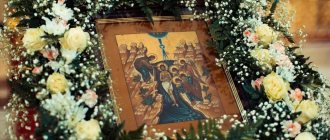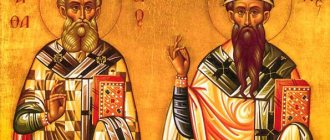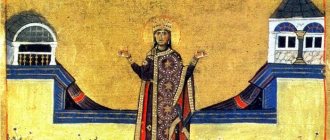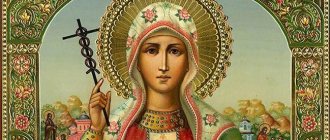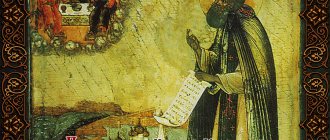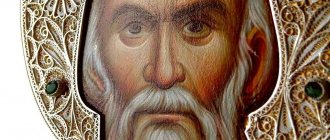Life of Saint Elizabeth Feodorovna
At the end of the 20th century, the name of Princess Elizabeth Feodorovna was included in the list of Orthodox saints. The sister of the last Empress of Russia was canonized by the Church in 1992. Followers of Christianity revere Saint Elizabeth because of her tragic death and the social activities she was involved in during her lifetime.
Origin and childhood
Elizaveta Romanova was born on October 20, 1864 in the German city of Darmstadt. The parents of the future princess were Prince Louis IV and the daughter of the British queen, Princess Alice. The girl was brought up in the classical tradition, which implied a strict attitude, instilling modesty and simplicity in decor, food and behavior. From an early age, Elizabeth was independent: she cleaned her room, made her bed and lit the fireplace. The girl’s parents taught her to love the people around her, so the girl’s mother went with her to shelters, hospitals and homes for the disabled, taking with her flowers and useful things for those in need.
Many people who knew Elizaveta Fedorovna from childhood noted that she always showed love for others and was a religious person. Her life was greatly influenced by the exploits of St. Elizabeth of Thuringia, after whom she was named. A tragic moment in her life was the death of her three-year-old brother, who suffered from hemophilia and lost consciousness after falling from a balcony. Seeing what happened, Elizabeth plucked up courage, picked up the bloodied child and carried him into the house. Later, a diphtheria epidemic broke out, as a result of which the girl's sister Mary and Princess Alice died. Queen Victoria became the guardian of orphaned children.
Marriage
At the age of 20, Elizabeth became a princess by marrying Prince Sergei Alexandrovich, brother of Emperor Alexander III. She knew him since childhood, when the future prince was visiting his mother in Germany. All candidates for the role of Elizabeth’s husband were rejected, and only Sergei Alexandrovich managed to win the girl’s heart.
After the wedding, the prince bought a palace in St. Petersburg for his young wife Elizabeth. Having moved to a new place, Elizabeth began to actively study the intricacies of the Russian language, understand the culture and, under the influence of her religious husband, became imbued with the Christian faith. In 1891, Elizabeth's husband was appointed governor-general of Moscow, and the couple moved to the capital. As the wife of the city's governor-general, Princess Elizabeth performed numerous public duties, including organizing parties, concerts, dinners and balls.
Serving the Lord
February 1906 brought sadness to Elizabeth when her husband was killed by a bomb planted by terrorist Ivan Kalaev. After the death of her husband, Elizabeth prayed often, observed strict fasting and did not attend social events. After some time, the holy princess began to create the Martha and Mary Convent of Mercy, for which she acquired an estate with a garden and several outbuildings.
A priest worked on the territory of the monastery, a church, a hospital, a pharmacy, a library and a school for orphans were built.
The name of the monastery is dedicated to the holy evangelical women wearing myrrh - Mary and Martha, who represent images of prayer and activity in approaching the Almighty. The Monastery of Mercy under the tutelage of the Holy Princess Elizabeth was different from others and was not a monastery in the classical sense. In this monastery, social service was directly and very closely connected with the Orthodox faith.
Martyrdom
Elizabeth spent most of her time on the territory of the Monastery of Mercy, and when in 1916 an angry crowd appeared at its gates demanding the release of a German spy, the princess’s brother, she herself went out to the people and offered to check the territory. At this time, the Lord saved the holy princess Elizabeth from misfortune, but after the revolution, an armed crowd again approached the monastery, intending to arrest the princess, suspecting her of espionage and storing weapons in the monastery.
The princess, along with her assistants, was captured and imprisoned on the outskirts of the city of Alapaevsk. The sisters who accompanied the abbess were offered release, but they begged to return to Grand Duchess Elizabeth. On the night of July 5, 1918, the martyr Saint Elizabeth and other representatives of the imperial house were thrown into the shaft of the abandoned Nizhne-Selimsky mine. At that moment when the tormentors abandoned the holy great martyr, she said a prayer to the Almighty.
Childhood and youth
Elizabeth was born in 1864 in Darmstadt, in the Duchy of Hesse. Until 1918 it was a separate state; now its lands are part of Germany. Her father was the ruler of the duchy, Ludwig IV, and her mother was the daughter of Queen Victoria of Great Britain, Princess Alice. Their marriage produced 4 more daughters and 2 sons. The eldest son, named Ernst Ludwig, subsequently took his father's throne and remained on it until the revolutionary events of 1918.
Elizaveta Fedorovna in childhood with her family
For the first two years, the royal couple did not have a residence. The Duke's influential mother-in-law insisted that a palace be built for her daughter using funds from the Hessian treasury, but the son-in-law resisted in every possible way, since there were no resources for this. The family moved from one rented mansion to another.
Over the years, the conflict between Elizabeth's father and her grandmother grew. Relations between the spouses also began to deteriorate. Their life together was overshadowed by the tragedy with their youngest son, Friedrich. When Ella - this is the nickname given to the girl in the family - was eight years old, her two-year-old brother died after falling out of a window. Duchess Alice increasingly spent time with her mother, taking her children to England.
Elizaveta Fedorovna and Alexandra Fedorovna
4 years later, the princesses of Hesse-Darmstadt and the future ruler of the duchy were orphaned, having lost their mother and younger sister Maria due to diphtheria. Since that time, both Ella and her sister Alix - the future wife of the Russian Emperor Alexandra Feodorovna - have been brought up mainly in the palace of the British crown, located in the city of East Cowes. Classes on housekeeping, religion, and etiquette are provided for girls. They are attracted to participate in charity.
Relics
When the White Guards arrived at the scene of the princess’s death, the bodies of all those thrown into the mine were taken out. A funeral service was held in the cemetery church, after which the bodies were taken to the East. The remains of the great martyr were brought to Jerusalem, and the ark with the relics was placed in the Church of St. Mary Magdalene in the historical site of Gethsemane. She was canonized in 1981, and her relics are still in Jerusalem today. The day of her death is considered the feast day of St. Mary Magdalene.
Death
Chekists arrested the abbess in May 1918. She was escorted to Yekaterinburg, and in July she was taken to Alapaevsk. On the night of July 18, she was shot by the Bolsheviks along with other princes of the Romanov dynasty. The execution, on the orders of Vladimir Lenin, took place at a mine outside Alapaevsk. The wounded were pushed to the bottom, where they died of hunger and wounds.
Tomb of Elizabeth Feodorovna
In the fall, the territory came under the control of the white army, and the remains of the dead were taken abroad. Elizaveta Feodorovna, like the sister of the Marfo-Mariinsky Convent, Varvara, who was killed with her, is buried in Jerusalem. After the collapse of the USSR, she was canonized, and in 2009 she was posthumously rehabilitated by law enforcement agencies.
Iconography
Icons depicting the holy great martyr began to appear in 1992, when she was glorified by the Christian Church. The external features of the iconographic images are as follows:
- the princess is depicted wearing an apostle;
- In her left hand she holds a small copy of the Monastery of Mercy, and in her right hand a cross;
- On some icons, the nun Varvara is depicted together with the holy princess.
The Great Martyr is easily recognizable in both images. The presence of the white apostle and the pectoral cross of the martyr is due to the fact that during her lifetime she and her monastery made a vow to renounce carnal relations.
Prayers
Troparion of the Prmc. led book Elizabeth, voice 1
By humility you hid your princely dignity, / the godly Elisaveto, / through the deep service of Martha and Mary, / you honored Christ. / By mercy, patience and love, you chose to honor yourself, / like a sacrifice you have offered yourself to God as a righteous woman, / but we, who honor your virtuous life and suffering, / as We earnestly ask you to be a true mentor:/ Holy Martyr Grand Duchess Elizabeth, // pray to Christ God to save and enlighten our souls.
Kontakion prmts. led book Elizabeth, voice 2
Who tells the story of the greatness of the feat of faith: / in the depths of the earth, as in heaven of lordship, / the passion-bearer Grand Duchess Elizabeth / with the angels rejoicing in psalms and songs / and enduring murder ,/ crying out for the godless tormentors:/ Lord, forgive them this sin,/ They don’t know what they are doing./ Through your prayers, O Christ God, // have mercy and save our souls.
What do they ask for in front of the image of the great martyr?
They turn to the image of the great martyr with prayers, asking for help and intercession before the Almighty. The Grand Duchess also helps in the following life situations:
- difficult childbirth;
- the birth of a premature baby and difficulties in subsequent care for him;
- cancer;
- suffering, torment and pain.
Since the Great Martyr, like any Orthodox saint, is very close to the throne of the Heavenly King, turning to her can be very useful. Performing prayers and hymns helps to deal with problems, find the right path and get rid of difficult life troubles.
Memory
- Several Orthodox monasteries in Belarus, Russia, Ukraine, as well as churches and chapels are dedicated to the Grand Duchess.
- The monument to the Grand Duchess was erected on the territory of the Marfo-Mariinsky Convent in 1990. In 2022, another monument was unveiled, installed at the Elizabeth Hospital in Perm.
- In 1993, the city hospital in St. Petersburg was named in honor of the Holy Martyr Elizabeth.
- In 2022, on the centenary of the death of the princess, the documentary film “The White Angel of Moscow” was released.
Prayer text
“Oh, holy new martyrs of Russia, Grand Duchess Elizabeth and her godmother sister, the faithful nun Varvara, both died in many torments, having fulfilled the Gospel commandments by feat in the monastery of mercy, entering death in these last times for the Orthodox faith and bearing good fruits in enduring their sufferings for Christ! Pray to him, as the conqueror of death, so that he strengthens the Orthodox Church in Russia and our Motherland, redeemed by the blood and suffering of the new martyrs, and does not allow the enemies of Russia to devastate our possessions. For this reason, the evil enemy has taken up arms against us, seeking to destroy us with internal strife, sorrow, unbearable grief, illness, want and oppression. beg the Lord to crush all their insolence and strengthen faith in the hearts of the Russian people, so that when the hour of testing comes, through your prayers we will receive the gift of courage, self-denial, taking up our cross and following Christ, crucifixion of our flesh with passions and lusts. Save us from all evil, sanctify the paths of our lives, grant us sincere repentance, peace and rest for our souls, beg the Lord that all bitter sorrows and eternal torment be forgiven us, so that we become heirs of the Kingdom of Heaven along with all the saints who pleased God from the century; that we may joyfully give glory, honor and praise to the Father and the Son and the Holy Spirit forever and ever. Amen".
(function(w, d, n, s, t) { w[n] = w[n] []; w[n].push(function() { Ya.Context.AdvManager.render({ blockId: 'RA -613525-6', renderTo: 'yandex_rtb_R-A-613525-6', async: true }); }); t = d.getElementsByTagName('script')[0]; s = d.createElement('script' ); s. type = 'text/javascript'; s.src = '//an.yandex.ru/system/context.js'; s. async = true; t.parentNode.insertBefore(s, t); } )(this, this. document, 'yandexContextAsyncCallbacks'); "+"ipt>"; cachedBlocksArray[158012] = "(function(w, d, n, s, t) { w[n] = w[n] []; w[n]. push(function() { Ya.Context.AdvManager.render ({ blockId: 'RA-613525-3', renderTo: 'yandex_rtb_R-A-613525-3', async: true }); }); t = d.getElementsByTagName('script')[0]; s = d .createElement('script'); s.type = 'text/javascript'; s. src = '//an.yandex.ru/system/context.js'; s.async = true; t.parentNode. insertBefore( s, t); })(this, this.document, 'yandexContextAsyncCallbacks'); "+"ipt>"; cachedBlocksArray[158015] = "(function(w, d, n, s, t) { w[n] = w[n] []; w[n] push(function() { Ya.Context.AdvManager.render( { blockId: 'RA-750735-16', renderTo: 'yandex_rtb_R-A-750735-16', async: true }); }); t = d.getElementsByTagName('script')[0]; s = d. createElement('script'); s.type = 'text/javascript'; s. src = '//an.yandex.ru/system/context.js'; s.async = true; t.parentNode. insertBefore(s , t); })(this, this.document, 'yandexContextAsyncCallbacks'); "+"ipt>"; cachedBlocksArray[158014] = "(function(w, d, n, s, t) { w[n] = w[n] []; w[n] push(function() { Ya.Context.AdvManager.render( { blockId: 'RA-750735-15', renderTo: 'yandex_rtb_R-A-750735-15', async: true }); }); t = d.getElementsByTagName('script')[0]; s = d. createElement('script'); s.type = 'text/javascript'; s.src = '//an. yandex.ru/system/context.js'; s.async = true; t.parentNode.insertBefore(s , t); })(this, this.document, 'yandexContextAsyncCallbacks'); "+"ipt>"; cachedBlocksArray[154156] = ""; cachedBlocksArray[154155] = ""; cachedBlocksArray[154154] = "".
Character of the birthday girl
The name Elizabeth can be found in many ancient manuscripts and writings. Many biblical legends also contain this name. Translated from Hebrew, it means “an oath before the Lord.” When a girl is called that, it gives her:
- positive and light power;
- assertiveness;
- determination;
- authority.
Since childhood, Lisa has been distinguished by her active work, the desire to become the best in absolutely everything. And this is truly interesting and important to her.
The best article for you, go to: Day of the Angel Veronica according to the church calendar
Lisa never engages in aimless work. She always knows what she wants. She has always had enormous ambitions and the makings of a strong leader. But at the same time, she knows how to have fun and gives everyone around her joy, warmth and attention. In life, she plays exclusively leading roles.
A girl with this name is also generous and sweet. But he knows how to insist on his own and show firmness where necessary. She will never take a step back.
Icon of St. Elizabeth the Wonderworker
Icon of St. Elizabeth the Wonderworker. End of the 19th century. Cathedral of St. John the Baptist Monastery
January 6/19, 2002 to the St. John the Baptist Monastery from the Church of Sts. App. Peter and Paul on the Yauza, two revered shrines of the monastery were returned: the ancient miraculous image of the Holy Prophet, Forerunner and Baptist of the Lord John with a hoop and the icon of St. St. Elizabeth the Wonderworker, Abbess of Constantinople. Church of St. App. Peter and Paul, which was not closed during the Soviet period, became the guardian of these shrines of the Ivanovo monastery by God's providence, to which they returned soon after the revival of monastic life in it.
Let us first turn to the image of St. Elizabeth, since her church was the first to be restored in the monastery in 1995, and before the consecration of the Cathedral of the Beheading of St. John the Baptist, services were performed in the house Elizabeth church. Icon of St. Elizabeth the Wonderworker was written in the second half of the 19th century for the new cathedral of the monastery, which was restored in 1879. The monastery existed for no more than 40 years after its renewal. In 1918, it was one of the first to be closed, and a concentration camp was located on its main territory. The cathedral continued to operate together with the Elizabethan Church until 1926 and early 1927.
According to the inventory of property that was in use of the Orthodox Christian Society at the Church of St. John the Baptist, in 1923 this image was in the main altar of the monastery Cathedral: “Icon of St. Venerable. Elizabeth in an icon case under glass with a chased gold border, picturesque, size 11/2 arch. x 1 arsh. 3 inches*"1. The icon is made, like many other similar icons, on metal - zinc. This is evidenced by the same inventory: “In the walls of the temple there are picturesque images of saints of various sizes in gilded baguettes on zinc and linen”2.
After the closure of the Cathedral of St. John the Baptist at the end of 1926 - beginning. In 1927, the community of believers moved with some of the church property of the monastery to the church of St. Trinity in Serebryaniki. Icon of St. Elizabeth is in the “Inventory of liturgical objects and church property transported from the temple b. Ivanovo Monastery to the Church of St. Trinity in Serebrenichesky Lane”3 dated April 30, 1927. When the turn of closure came to the Church of St. Trinity, icon of St. Elizabeth was transferred to the Church of St. App. Peter and Paul.
Now the restored icon of St. Elizabeth the Wonderworker is located in the Cathedral of St. John the Baptist Monastery of St. John the Baptist4.
House church in the name of St. St. Elizabeth the Wonderworker in the John the Baptist Convent was established with the blessing of St. Philaret of Moscow and according to the will of the wealthy widow and benefactor of the monastery Elizaveta Alekseevna Makarova-Zubacheva in honor of her heavenly patroness.
By the providence of God, the ancient holy abbess of the 5th century, Elizaveta the Wonderworker, inspired Elizaveta Alekseevna with the good idea of reviving the ancient Moscow monastery, devastated by the French in 1812. Elizaveta Alekseevna, remembering her late husband, the same name as John the Baptist, and with the prayers of St. St. Elizabeth, fulfilling the will of God, bequeathed her entire considerable fortune to the renovation of the monastery. And the holy abbess Elizabeth became one of the patrons of the St. John the Baptist monastery.
The image of the reverend abbess is made in a soft combination of pink, blue and soft greenish shades, and shows us the spiritual appearance of the saint. St. Elizabeth is depicted in full growth standing on the bank of a river or lake, behind which the outlines of a number of low hills can be seen, as if in a light haze. The saint is clothed in a reddish color, similar to the earth at her feet, a tunic and a green mantle, which, like the blue of the heavens around her, covers her. The head of the saint is shrouded in a lilac omophorion and a schematic pendant of the same color is visible under the mantle on the tunic. There are no external symbols of the abbot’s power on the icon, but the prayerfully focused face of the Holy One and the restrained, integral and soft appearance reveal in it the gifts of unceasing prayer before the Lord and spiritual power - care for those who ask for her help. Her right hand is bent towards her chest and, as it were, points to her heart, which is constantly turned to God. Left hand of St. Elizabeth holds an unfolded scroll with the words of prayer for all those who come running under her protection:
“Lord my God, hear me, grant remission of sins to the one who remembers the name of Elizabeth, and at the hour of departure, accept his soul in peace and give him a place of peace.”
Such is the spiritual power, strength and boldness of the saint, who cares about the forgiveness of sins, repentance and the eternal fate of souls, for which she calls on the mercy of God.
A special providential gift and truly a miracle of God was the discovery of the complete life of St. Elizabeth, which was preserved only in one Florentine manuscript of the 14th century, discovered in the 50s. XX century5, Its first edition was carried out in 1973 by the Catholic scholar-hagiographer, member of the Bollandist Jesuit congregation, Fr. François Alquin in the collection Analecta Bollandiana 916. The Bollandists are known as a society of learned monks engaged in the research and publication of the Lives of the Saints of the Eastern and Western Churches. The activities of this society were started in 1643 by John Bolland7. Several years ago, the life was translated from Greek into Russian by the historian A.Yu. Vinogradov and first published in Russian by the St. John the Baptist Monastery in 2002. In it St. Elizabeth the Wonderworker is not only the patroness of female cenobitic monasticism, but also the vessel of the Holy Spirit from which flow the grace-filled gifts of miracles and healings from various diseases.
Even before her conception in her mother’s womb, she was given the name of the righteous Elizabeth, the mother of John the Baptist, “for (as the life tells) she will turn out to be like the mother of the Baptist and Baptist John”8. As a daughter given by God to barren parents, she undoubtedly has the grace to help those burdened with this sorrow. Very young she became the abbess of the monastery of St. Vmch. George in Constantinople, where her paternal aunt had previously been abbess. In the abbess of St. Elizabeth was installed by Saint Gennadius, Patriarch of Constantinople (458-471). Thanks to her deepest humility and truly monastic life according to the Gospel commandments, the Lord granted her many gifts at a young age. She healed incurable diseases, cast out demons in the name of Christ, received many revelations and predicted the future for the salvation of her neighbors. Thus, she predicted a terrible fire in Constantinople in 465, which was extinguished by the power of the prayers of St. Elizabeth and etc. Daniel the Stylite; She also delivered one of the outskirts of Constantinople from the terrible serpent that was destroying people. She provided special assistance to many women who suffered from continuous female bleeding; healed from blindness. She was notified 24 days in advance of her death, for which she prepared and, with her constant instructions and teachings, prepared the sisters of her monastery, and blissfully gave up her spirit to God after the patronal feast day in her monastery of St. Vmch. George. After her death, by the power of God, she performed the same miracles of healing as during her life: she healed a withered man, a blind man, and a demon-possessed man; many other miracles “because of their abundance” are not described in detail in the life, “but are recorded elsewhere”9.
St. St. Elizabeth the Wonderworker, the patroness of the St. John the Baptist Monastery, still prays for all those who resort to her help. She was connected by a special spiritual relationship even before her conception and birth with St. Prophet John and his righteous parents more than fifteen centuries ago. And we see this special prayer cover and unity in our monastery in the construction and revival of two churches of St. St. Elizabeth and St. Prophet John, and in the simultaneous return of two shrines after the opening of the monastery.
* Arshin = 71.12 cm (16 vershok), vershok = 4.445 cm.
1 - TsGAMO. F 66. Op. No. 18. D. No. 334. L. 18 vol.
2 Ibid. L. 22 rev.
3 Ibid. L. 46. No. 9.
4 In 2002, the icon was placed in the house Elisabeth church of the monastery, where it remained until 2005. At the request of pilgrims, with the blessing of the abbess of the monastery, the icon was transferred from the house church to the cathedral.
5 Bibliotheca hagiographica graeca. Bruxellex, 1957. No. 2121.
6 Orthodox Encyclopedia. M., 2001. T. 2. P. 79, 213.
7 Lives of Saints St. Demetrius of Rostov. 1991. September. Book 1. P. XXVI.
8 Life of the Venerable Elizabeth the Wonderworker. M.: Ioanno-Predtechensky Monastery, 2002. P.6.
9 Ibid. P. 13.
